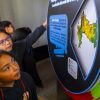Real-time analysis, alarms and automatic detection of possible damage to road structures are part of the benefits of the project created by, the engineer from the Universidad de Concepción, Gonzalo Rojas; a web platform that allows the behavior of bridges in Chile to be monitored and which also seeks to be incorporated into the Manual of Highways of the country.
By: Carolina Vega / cvegaa@udec.cl
/ Photographies: Courtesy of FI UdeC
What does a civil computer engineer do working on a bridge-related project? In fact a lot, because although Gonzalo Rojas, also a doctor in Software Engineering, usually works with other disciplines, he had never had to do it in civil works. The invitation came from, the then academic, Fernando Cerda when he decided to join the project “Bridge structural monitoring platform”.
Thus, with Fernando Cerda as project director and Nicolás Ortega, civil engineer in charge of project management, Rojas began a new path as alternate director in an interdisciplinary investigation, where bridge monitoring has a strong computer component, both in the development of a software platform which captures data from sensors, as well as in its subsequent analysis and implementation of machine learning algorithms in order to establish some conclusions regarding the collected data.
“This project emerges as a need to complement the visual inspection methods currently implemented in our country, in order to favor early detection of damage and less expensive maintenance than the one carried out when deterioration is evident,” Gonzalo Rojas contextualizes.
What is this Project about?
The Project consists in generating the documentary base and the software platform to monitor the structural integrity of the bridges. This allows knowing key and complementary aspects in the bridges monitoring through the integration of multiple sensors, connected to a computer on site, which collects and transmits the data wirelessly.
What information does it provide?
This platform captures the data and delivers different levels of analysis. These are:
1. – Real-time analysis: Providing information to verify the normal operation of the installed sensors so that, in the event of problems, specialists can incorporate them into maintenance cycles.
2. – Real-time alerts: Indicating when the data is abnormal, according to the established norm, product of eventual loads, such as excessive weight or seismic event.
3. – Recent signal analysis: Statistically analyzed, with visualizations such as line or bar graphs and histograms and up to 14 days ago, in order to characterize, a little more and, in a more leisurely way, the behavior of the sensor and measurement infrastructure in a significant period and thus to draw certain conclusions.
INNOVATION
One of the innovations in the development of this software or platform is related to the incorporation of certain parameters of the BIM method (Building Information Modeling), which is becoming increasingly relevant in the field of Civil Engineering and which will be a mandatory requirement in public projects. BIM models allow a civil work to be characterized through a set of hierarchical descriptors of structures, layers, materials, etc., generating a visualization of the bridge in 3D. “Our platform has an open access, so it can be used by specialists from the Ministry of Public Works as well as Chilean researchers and investigators from other countries, so we need the web environment and it is very demanding in terms of resources to explore a 3D structure. However, we could filter this BIM structure, rescuing the most relevant aspects for an exploration and we can currently provide an exploration not only of the structure in 3D, but also of the sensors that were installed there and we can see, with a fairly close approximation to reality, where they are installed, their current status and other data”, points out the researcher from the Faculty of Engineering.
This way, the sensor information and the on-site review provide valuable information for a better and more economical maintenance. In this sense, the director of the project, Fernando Cerda, highlights the positive trend when incorporating these issues in the construction of new bridges: “several current tenders are already incorporating the requirement of a monitoring system and it is very gratifying that the Road Management Administration is making great efforts to consider the use of instrumentation and platforms such as those of the project”.
And, finally, a very important functionality is the possibility of automatically detecting possible damage from the collected data. “We are using autoregressive models, which is about detecting thinner anomalies, based on past normal behavior of the same sensor,” says Rojas, who also highlights that the project includes an instrumentation methodology, a proposal that could soon be incorporated into the Manual of Roads that governs the road infrastructure in Chile.
And what is next? The team is creating a procedure which will allow new bridges to be easily incorporated into the platform, since a new one will be added soon and it will be operated by specialists from the Bridges Management of the Ministry of Public Works.
For more information, please contact:
gonzalorojas@inf.udec.cl
Last modified: 29 de agosto de 2025






